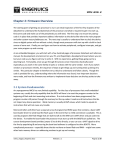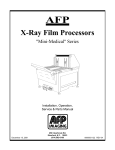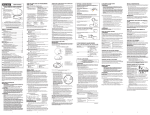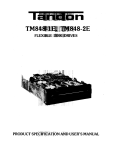Download Chapter 1: Hardware
Transcript
MPG LEVEL 2 Chapter 1: Hardware The development board for this course is very much like a prototype board you might do for a product developed in industry. The main elements are the microcontroller, LCD, and ANT radio, and the board is supported with the user input (trackball and buttons) as well as a power supply. However, the board also has a few extras like a UART for programming or otherwise communicating (perhaps for debugging) and a daughter board connector for future expansion. This chapter examines the key components to discuss why they were chosen and provide an overview of their capabilities, then goes over the schematics to explain all of the circuits. We conclude with a look at the PCB and discuss the important decisions made in positioning components and routing the board. 1.1 Selecting a Microcontroller The Cortex family of microprocessor cores seems to be having an immense impact on the embedded system industry, as evidenced by the fact that virtually every microcontroller manufacturer who has had their own proprietary lineup of parts has added a Cortex-based lineup as well. Developers who used 8 and 16-bit micros due to their low power consumption and low cost over 32-bit parts like those based on the ARM7 are now considering the higher power Cortex parts that compete in power consumption and cost, yet still offer the greater capability of a 32-bit architecture running the very powerful ARM instruction set. Another huge advantage to an ARM core is scalability. Just as the ARM7 scaled to ARM9 and ARM11, Cortex parts scale from M0, M1, M3, and M4. There are additional Cortex parts that scale all the way up to application processors that run in the GHz speeds and essentially compete with Intel and PowerPC. Figure 1.1.1 shows the ARM cores available as of June 2010. Figure 1.1.1: ARM processor cores. Source: http://www.arm.com/products/processors/index.php notes_mpgl2_chapter1.docx Version 1.1 Page 1 of 37 MPG LEVEL 2 Every designer should recognize the value of this type of scalability. As someone who is taking this course can attest to, learning a new microcontroller takes a lot of time and effort, not to mention costs in hardware and design tools. Moving through the ARM family allows you to reuse many of the same skills you have already invested hundreds of hours in. ARM has taken a step further with an attempt to provide some compatibility across vendors who are integrating their cores. They have introduced the Cortex Microcontroller Software Interface Standard (CMSIS) which dictates how manufacturers should build their microcontrollers around the Cortex core. In the past, designers have to look at the header file(s) for a new processor and figure out the conventions that are used by the manufacturer for naming registers and bits and then ensure their firmware follows those conventions. If you made the switch to another vendor, you had to spend a fair bit of time getting used to the new vendor’s conventions and updating all of your code to be compatible. The magnitude of this type of inconvenience was begging for a standard, and finally CMSIS is starting to gain traction. For example, NXP, ST and TI (among others) all make a microcontroller based on a Cortex-M3 core. They all include similar peripherals like UARTs and Timers and interrupts and analog to digital converters. If they follow the CMSIS rules then the registers, configuration and general operation of their respective peripherals will be very much the same so that developers can write generic code that will work on any platform. Since this is starting to sound like an advertisement for ARM, now is a good time to offer some criticism. First of all, not everything will be identical between processor vendors, but as much as possible will be at least at a certain layer of the software (when it gets down to the nittygritty like register base addresses, there will probably be some processor-specific code required). As it so happens, most of the original development for this course was completed on an STM32F103VC Cortex-M3 part from ST Microelectronics, and then ported over to the NXP LPC175x. This provided firsthand experience with using the wonderful promises of CMSIS, and it actually did make the conversion go fairly smoothly. Though many of the specific register names within peripherals were entirely different, the structure of the code and the conventions for register and bit accesses were very similar. Having taken the time to become familiar with those conventions of CMSIS allowed certain tasks to be completed faster and even some assumptions to be made that helped speed things up. On the other hand, there were a lot of minor differences that were just irritating. For example, the ST part uses alphabetic characters for GPIO ports while NXP uses numerical values. The CMSIS standard for accessing GPIO is with a pointer-to-structure-like definition like GPIOx->peripheral_register where ‘x’ is the port name. Since ST’s GPIO port names were GPIOA, GPIOB, etc., it was correctly assumed that NXP’s GPIO names would be GPIO0, GPIO1, etc. That made making these firmware changes relatively quick and easy from a structure point of view, but still required some work since ST uses a “BSRR” (bit set-reset register) while NXP uses “FIOSET” (bit-set register ). notes_mpgl2_chapter1.docx Version 1.1 Page 2 of 37 MPG LEVEL 2 Beyond the basics of register and bit naming, CMSIS also tries to standardize how basic processor operations are performed. This is a reasonably well-intentioned idea, but like any application of a standard, there tends to be some added cost in overhead. For example, CMSIS provides a universal set of functions for setting GPIO functionality. A CMSIS purest would use these function calls to setup all their IO, even though that could mean literally hundreds of function calls to completely set up a large processor. The same configuration could be done by just a few hardware-specific instructions. Of course, the code is no longer portable and definitely not “CMSIS Compliant.” As we have already discussed, the fact that low-level drivers will still need processor-specific code also raises some doubt about the attainability of true universality amongst vendors. Frankly, processor vendors may choose to purposely resist CMSIS in some areas to maintain some individuality and lay claim to some sort of superiority as a result. In reality, a company will likely stay with a certain processor vendor unless there are very compelling reasons to change like a special feature or an amazing price that cannot be met by any other manufacturer. Aside from that, even changing parts in the same family will require some code maintenance regardless of whether or not the CMSIS standard has been followed, simply because the resources and their allocation will change along with the microcontroller selected and its application. All that being said, using a Cortex part has many advantages regardless of the target application and completely independent of whether a designer chooses to follow the CMSIS spec (though given the porting experience from ST to NXP, using CMSIS conventions are definitely recommended). Cortex-M3 parts have been out for only a few years, but the traction they have gained due to their excellent overall performance has no doubt positioned the part for success for many years to come. Choosing the Cortex-M3 LPC175x for this course was very purposeful to ensure all the skills here are with one of the most up-to-date and relevant microcontrollers on the market right now. The decision on processor choice for this course came down to two vendors who had parts that were essentially equal. The development board requires a device with the following: 1. 2. 3. 4. 5. 6. 7. 8. UART interface for serial programming and debugging SPI interface for ANT I²C interface for the LCD I²C and SPI interfaces for the Engenuics daughter board connector GPIOs for 7 button signals, 4 LEDs PWM output for the buzzer A minimum of 8kB of RAM for the LCD plus at least 1kB for other processor operations An estimated 10kB of flash memory for the program plus 10kB of flash available for LCD bitmaps Both ST Microelectronics and NXP Semiconductors offer attractive Cortex-M3 parts that can meet the requirements for the development board. To be consistent with MPG Level 1, the NXP part was chosen. This allows one to leverage the familiarity in the conventions and styles of a single company in their notes_mpgl2_chapter1.docx Version 1.1 Page 3 of 37 MPG LEVEL 2 documentation, architecture decisions and example code. Specifically, the LPC1752 part is used as it has 64kB of Flash and 16kB of RAM – plenty for our requirements. Higher parts in the family offer a few more features and of course more flash and RAM, but none of these are necessary for this project so we decide to pick a lower-level part due to cost. All processors in the family are pin-for-pin compatible with each other, so if ever a feature of a higher part was required, then it could simply be dropped onto the board. 1.2 LPC175x Cortex-M3 Microcontroller Familiarizing oneself with the processor pin map is a good starting point in a design. Figure 1.2.2 on the following page shows the complete pin-out of the processor. Every possible function of every pin is indicated and the pins are shown in the correct order, though the part is drawn with pins on only two sides instead of on all four sides as the part is actually configured. This is a good time to remind the reader that the schematic symbols in CAD software are just that: symbols. Their appearance and pin positions have no bearing on how the device is actually configured. Only the pin number and the signal attached to it are important and the user must be able to assign pins per their correct functions. The CAD software looks only at the pin number to map the connection to the correct location on the PCB land pattern for the part. Information to build this symbol was taken from the processor datasheet where each pin is listed with its name and all available options. Often the device manufacturer will show a complete symbol like Figure 1.2.2, but with this processor they have not. An abbreviated representation of the actual pin locations and physical positioning on the chip are shown in the processor data sheet and repeated here in Figure 1.2.1. Figure 1.2.1: Pin configuration for the LPC175x processor in LQFP package Source: LPC1759_58_56_54_52_521 Product data sheet, Rev. 04 – 26 January 2010, NXP Semiconductor Building the schematic symbol is admittedly tedious but also very, very critical to complete correctly. If a pin is assigned incorrectly, then the entire design will be flawed along with any other design that notes_mpgl2_chapter1.docx Version 1.1 Page 4 of 37 MPG LEVEL 2 makes use of the symbol from the schematic library. It is therefore highly recommended that the symbol be checked and rechecked by at least two pairs of eyes. Once the base symbol is verified, application-specific symbols can be created where pins are moved around and grouped to best fit on the schematic page and attach to the other circuits in the design. We will see this a little later on. Figure 1.2.2: LPC175x Microcontroller Pin-Out Schematic Symbol notes_mpgl2_chapter1.docx Version 1.1 Page 5 of 37 MPG LEVEL 2 1.2.1 Pin Allocation The next somewhat tedious task is assigning pins to the circuits in the design. The block diagram of the device is a good tool to assist in this, and in fact can be improved at this point by adding more specific information. Virtually every GPIO pin on the LPC175x processor has several options available for how it can be used. For example, pin 80 is the Port 0.3 GPIO, UART0 receive data line (RXD0) or one of the analog inputs. It is important to investigate each pin before mapping begins to determine if there are any critical functions you need and how using different pins will impact the remaining functionality available on the other pins. In general, the order of assignment should be something like this: 1. No-choice pins: power, ground, clocks, etc. can be hooked up first just to get them out of the way. All power and ground pins need to be connected. It is suggested that JTAG pins for programming / debugging fall into this category as well even though some processors allow you to multiplex GPIOs onto these. This is a highly unadvised practice if you plan to load your device over JTAG, or if you do any debugging. The LPC175x does not multiplex any of the programming pins, so here you do not have to worry about it (the alternate signals shown for some of the JTAG pins are for different types of debuggers). 2. One-of / special function pins: any signal / peripheral that you need that is available on only one pin must be assigned first since there are no other options. If two such signals you need are only available on one pin, then you either have to figure out if you can multiplex them somehow (perhaps with an external mux), select a different processor, or change your design. 3. Peripheral-connected pins: these include communication ports, interrupt pins, analog pins, PWM pins, timer/counter pins, etc. Often there are multiple choices to content with. For example, you may only need 3 analog inputs, so pick pins that do not have other useful functions on them. Communication ports can also be selected to ensure you get everything you need. For example, since the LPC175x has four UARTs but only two I2C ports and since we need two I²C ports and only one UART, it would be logical to assign the I2C pins first, then use whatever remaining UART is available. 4. GPIO: signals that only need to be 0, 1 or Hi-Z can be allocated next. In general, it does not matter where you put these but you should still be aware of what functions you are giving up if you claim a pin. You must also ensure that the pin will do what you think it will do. Some processor GPIOs will only accept inputs up to the processor supply rail which may be an issue if you run a 3.3V rail but talk to another device with a 5V rail. Or, some pins might have opencollector drivers instead of push-pull drivers. GPIO assignment should also be influenced by firmware. For example, if you wanted to show an 8-bit counter on LEDs, then the LEDs should be assigned to consecutive pins on the same port if possible. This will help when writing code because the LED driver can write to consecutive bits in a single register to turn the lights on and off. If you randomly assign LEDs to pins all over the place, then it will require a bit more code to notes_mpgl2_chapter1.docx Version 1.1 Page 6 of 37 MPG LEVEL 2 map those and update the LEDs when required. Though a lot of times this cannot be avoided, any consideration and optimization will likely lead to a better product delivered in less time. 5. Unused pins: many designs will not need all the processor pins available. In this case, be sure to consult the processor data sheet to ensure you do the right thing with these unused pins. You may be able to leave them floating, or you might want to tie them high or low directly or through a resistor. If you have the space, it is highly recommended that you stick a test point on them so they are accessible should you decide to add something to the board or make a mistake. Almost all development boards would take the test point approach to maximize flexibility. If you are really unsure what to do with them, add both a pull-up and pull-down resistor in addition to the test point. Then you have all options available and the only cost is board space. Given all that information, we will allocate pins and peripherals as follows: 1. 2. 3. 4. 5. 6. LCD communication: I²C1 and Port 1 GPIO. ANT communication: SSP0 and Port 1 GPIO. UART ISP / serial debug port: UART0. Trackball / button inputs: Port 2 interruptible GPIO. Daughter board: I²C2, SSP1, UART3 and Port 2 interruptible GPIO. Remaining GPIO as required and all power, ground and clocks. The way this was all done was not at all arbitrary – the steps described above were taken exactly. First, the entire ”Pinning Information“ section of the datasheet was read to see if any particular pins had critical functions that must be used. Note that you need to be very careful when looking at datasheets that cover entire families of parts. To use this processor, we have two documents: a Product data sheet and a Product User manual. In this case, the “Product data sheet” covers only the LPC175x family that are all 80-pin devices. The “User Manual” covers the LPC17xx family (175x and 176x parts), which includes 100-pin devices. Therefore, the User Manual pin mapping has a pair of extra columns that differentiate the pin purpose on the 80-pin and 100-pin parts. Obviously the 80-pin package does not have all the signals that the 100-pin package has. Since this design has relatively few requirements and the processor itself does not allocate too many similar functions per pin, assigning pins was quite simple. In fact, the only pins that stood out from reading the pin map were those related to serial programming the device. Pin 41 is the signal used to enter boot loader mode after reset, and UART0 TXD0 and RXD0 are the communication lines over which the boot loader communicates. This is critical for using the serial programmer. Pin 41 is also shared with the external interrupt pin, EINT0. This investigation led to something that required specific attention: the external interrupt pins. notes_mpgl2_chapter1.docx Version 1.1 Page 7 of 37 MPG LEVEL 2 1.2.1.1 External Interrupt Pins On the LPC214x processor used in MPG Level 1, only 4 GPIOs could be configured as external interrupt sources (EINT0 – EINT3). The four buttons on that development board were therefore connected to those lines. On the LPC17xx family, the same EINT pins exist, however the processor datasheet says that all GPIO pins on Port 0 and Port 2 can be used as edge-sensitive interrupt sources. This is a good thing since we want all 7 of our button input signals to be on interruptible inputs. It is doubly good because the 80-pin package of the 175x series only offers EINT0. Though that does not sound like a very significant conclusion, it actually is and took a fair amount of time to understand. Investigation into all of it went like this: 1. Find the statement in the data sheet that confirms Port 0 and Port 2 are interruptible GPIOs. 2. Look at the Nested Vectored Interrupt Controller (NVIC) section of the data sheet to read what it says about external interrupt sources: the information about the GPIOs is repeated, so no additional help there. 3. Look at the NVIC section of the processor user manual. In Table 50: Connection of interrupt sources to the Vectored Interrupt Controller, see the note, “EINT3 channel is shared with GPIO interrupts.” No other information is found in the NVIC section. 4. Move to Chapter 9: GPIO in the User manual. Note reference to interrupts in “Basic Configuration.” In section 9.2.2, there is discussion of the generated interrupts. Since all pins on Port 0 and Port 2 share the same (single) NVIC line, it implies there will be a register to enable / disable particular port pins as being interrupt sources. The interrupt service routine (ISR) that handles this single interrupt source of the NVIC will therefore have to parse the different input signals to determine which caused the interrupt, then branch to the particular function to handle that interrupt. It also implies that a level of priority will be required in the event that simultaneous buttons are pressed. 5. Find table 9-101: GPIO interrupt register map. Here are the registers where individual pins can be set to provide rising and/or falling edge-triggered interrupts (the IntXEnR and IntXEnF registers, where X is 0 for Port 0 and 2 for Port 2). The status registers are also here (IntXStatR and IntXStatF) – these will hold the bits that the ISR will poll to see which interrupt occurred. 6. Discover that EINT3 is not physically present on the 80-pin parts. Therefore we do not have to worry about that input signal, and can just enable Port 0 and Port 2 interrupts as required. With this information confirmed, we can safely allocate all the buttons to any pins on Port 0 or Port 2 as we please, making this allocation less critical which could have caused conflicts with some of the communication peripherals that are also on Ports 0 and 2. notes_mpgl2_chapter1.docx Version 1.1 Page 8 of 37 MPG LEVEL 2 The next step in selecting pins was to print a copy of the schematic symbol in Figure 1.2.2 and write in any of the critical pins required. On this printout, any multiplexed function that was not needed for sure was crossed off to help narrow our selections down and make the picture clearer. Following the selection hierarchy, critical pins and no-choice pins were identified on the sheet. The UART selection was made next. Notice that only UART1 is a fully-defined UART with the hardware flow control lines Ring, DCD, DTR and DSR. However, we know from reading the pin documentation that UART0 must be used for the boot loader. At this point an important decision is made: should both UARTs be made accessible on DB9 connectors so that programming can occur on UART0 and a full UART can be provided through UART1; or does cost, space and functionality requirements override the need to make UART 1 accessible. The latter argument wins out, but as a consolation, the additional UART pins will be brought out to test points near the connector so it would be possible to tie in to the signals. 1.2.1.2 Pins with Multiple Connections Note that UART1 (and a few other peripherals) have signals that appear on several different pins. It took a bit of hunting to see how this was handled, but eventually the information was found in the product manual on page 103 (see excerpt below). Given this information, the UART pins were selected based on the two options available (Port 0 and Port 2). Port 2 was selected because none of the UART functions on those pins overlapped pins of other communication peripherals. With this selection made, the alternate UART1 pins can be crossed off since they are not needed anymore. For the SPI interface, the LPC175x family offers a single SPI peripheral, or two SSP peripherals. The dedicated SPI peripheral is a legacy device that is limited in functionality over an SSP peripheral. For our purposes, they function the same but we will implement our ANT SPI communication assuming the SSP peripheral. Since the pins are the same, it does not really matter. Since the UART1 functions of the pins where the SSP0 is attached have been crossed out, these were assigned next. Some of the other signals on the processor symbol could be selected next since they have only one peripheral option left, though we had to be careful to avoid taking Port 0 or Port 2 signals that are possible interrupt sources needed for the 7 buttons. The buzzer is assigned to P1.18 since it is a PWM output that has no other required multiplexed signal. P4.28 and P4.29 are not used for anything else so notes_mpgl2_chapter1.docx Version 1.1 Page 9 of 37 MPG LEVEL 2 they can be set to use UART3 for the daughter board connection. The remaining SSP pins for the daughter board are allocated. P1.0, P1.1, P1.4, P1.8 are set for LEDs and P1.9, P1.10, P1.15 are chosen for the LCD backlight control, LCD reset line and LCD chip enable line, respectively. The I²C busses are allocated somewhat arbitrarily: I²C1 is chosen for the LCD, while I²C2 will be for the daughter board. There were no other factors that contributed to selecting one over the other. The only consideration was to share an I²C bus with the LCD and daughter board. Since the LCD bus will be fairly busy and since we have plenty of pins available and a spare I²C peripheral, it makes the most sense to allocate one each to the LCD and daughter board. The remaining Port 0 pins are taken up with the seven button inputs. Though it would be nice for routing purposes to use P2.8 and P2.9 for the ANT_PWR and ANT_RESET signals, these are the only two remaining interruptible GPIO, so they are assigned to the daughter board. There are also four other GPIO ANT signals required that do not have any special needs, so choose the group P1.22 – P1.25 for them all. All leftover pins are unused. We will loosely allocate P1.30 and P1.31 as analog pins since they are the only remaining analog GPIOs. These and the rest of the digital pins will be given test points for future use. This entire exercise took about 3 hours to complete. Indeed it is a tedious task but obviously very important (just as tedious and important as getting the processor schematic symbol correct in the first place). For the sake of completeness, a scanned image of the symbol “worksheet” is shown in Figure 1.2.1.2.1 to show how truly a pen-and-paper exercise this is. The solid black-outs were done first for functions that were not needed for sure. The x-outs were done as it became clear that that particular pin function was not needed or not used. Circled pins are the functionality that must be assigned when we get to that part of the firmware. The notations on each pin indicate the target signal for the selected function. Note that every pin has been assigned, even if it is just to a test point as indicated by a small square. notes_mpgl2_chapter1.docx Version 1.1 Page 10 of 37 MPG LEVEL 2 Figure 1.2.1.2.1: Scan of completed pin mapping symbol worksheet Now that all of the pin assignments are complete, a device-specific processor schematic symbol can be made that does not need to show all of the unused pin options and organizes the pin-out in a way that will facilitate an orderly schematic. With that complete, the remaining hardware design and schematic capture can take place. notes_mpgl2_chapter1.docx Version 1.1 Page 11 of 37 MPG LEVEL 2 1.3 Development Board Schematic Review Even if you never design a circuit in your life, having a basic understanding of the hardware platform on which your firmware will run is invaluable if not essential. Not only do you learn about the choices and tradeoffs made in designing the circuits in the system, you also have an opportunity to contribute feedback through intelligent discussion. There is always an inherent rift between “the hardware team” and “the firmware team” who tend to blame the other when things go wrong. If you get to play both roles, then the only one you can blame is yourself. Even if doing both is not your full time job, having knowledge and experience with both allows you to quickly understand why both teams must contribute and ultimately make sacrifices to help each other out to successfully build a working product. At the beginning design stage of any product, both hardware and firmware teams should meet to discuss the project’s requirements, processor selection and planned approach for module communication and resource use. As soon as possible, the firmware team should supply an overview of their high-level design to hardware, and hardware should provide a block diagram or draft schematics. Final schematics should be reviewed and discussed, at which time the firmware team hopefully has a clear view of how their code will use the hardware. This is also a good time to share and clarify any assumptions made, such as how particular circuits are used, what the expected processor on-time is for power consumption, etc. Playing both sides of the equation, the MPG Level 2 processor resources were allocated and the hardware design was completed. The course development board is broken up into five schematic pages (the full schematic package is available on the MPG website) that cover the following: 1. 2. 3. 4. 5. Block diagram Power supply Processor ANT Radio User I/O Each circuit block will be discussed in detail to ensure a full understanding of the components and connections chosen for this design. The process of selecting the components is not entirely described here, though the general steps for everything can be summarized by the following: 1. Requirements definition for each circuit. 2. Part selection and evaluation based on previous experience, reference designs and/or new research and investigation. 3. Analysis, prototyping and testing as required (particularly for power supplies). 4. Schematic symbol creation (if parts are not already in your design library). 5. Schematic capture of the circuit. notes_mpgl2_chapter1.docx Version 1.1 Page 12 of 37 MPG LEVEL 2 Clearly this is one of the very handy advantages of working on a design that is already complete – many hours of work go into designing a product and correctly integrating the various circuits for the design. The sections discuss the final circuits chosen, but do not attempt to describe much of the decision making that led to the final selections. 1.3.1 Block Diagram Schematics can be captured entirely on a single page but can become cluttered quite quickly. The main advantage is that every circuit is available without flipping pages, and it can be easier to view and understand interconnections. There is also potential to reduce some errors that may arise from improperly naming signals lines between pages – many of these can be caught by the design tools, but some can squeak through. For multi-page schematics, a block diagram is used to show the interconnections between all the schematic pages (see Figure 1.3.1.1). Though this is not required by the design tools, it can help to ensure that every signal goes somewhere and can assist in identifying errors in defining the data directions of the lines. Figure 1.3.1.1: Schematic Block Diagram notes_mpgl2_chapter1.docx Version 1.1 Page 13 of 37 MPG LEVEL 2 The page symbols are automatically generated by the design tools though they have to be adjusted and resized to make all the connections between each page line up. Signal lines can be drawn between all the ports to explicitly show the connection, but this is another optional step as long as the project environment is configured to automatically connect like-named ports. A block diagram page is also a good spot to put non-electrical component symbols on and other design notations that are relevant. In this case, the PCB label is shown along with two fiducial markings that are used as reference locations for SMT PCB population. Both the label and the fiducials have corresponding PCB land patterns that will appear on the PCB. 1.3.2 Power Supply The essence of any good design is a quality, stable power supply. The first challenge of a power supply design is getting a simple circuit to operate properly over the lowest, nominal and peak loads that the supply is expected to source. With a linear regulator, this is generally easy. With a switching power supply, it is much more difficult especially if noise and board space are concerns. The MPG Level 2 design (see Figure 1.3.2.1) leverages the same proven supply from the development board used in MPG Level 1 and provides 5V and 3.3V rails. The switcher is highly robust and supports a wide voltage input range anywhere from 7 to 30V. The relatively low switching frequency bodes well for avoiding RF interference or any other interference with MHz-frequencies on the device. Large capacitors are used to provide ample current sourcing for transient response and stability, and a large inductor is used to store plenty of energy. The power supply is also quite reasonably priced given the components it requires. Figure 1.3.2.1: MPG Level 2 development board power supply notes_mpgl2_chapter1.docx Version 1.1 Page 14 of 37 MPG LEVEL 2 The power supply has a “TVS” (transient voltage suppressor) clamping diode (D2) on the 5V output to deal with any input transients that were found to appear with certain transformers that power the board. There is also a fuse (F1) to help those with not-so-great soldering techniques from destroying parts on their boards through ground shorts. On that note, prior to applying any power to the board, do a continuity check from the 5V test point to ground and from the Vcc test point to ground to check for shorts. This design also “dual-footprints” the input and output capacitors so either thru-hole or SMT parts can be used. This is a matter of pricing and availability more than design performance. The LDO was chosen as it has a common footprint across several vendors and the adjustable output can address any changing supply needs down the road. A DC wall wart or a 9V battery is used to power the board. The J-Link power supply can also directly power the 5V rail and is diode-protected so you can safely plug the J-Link into the board when the board is powered externally. Because of the diode, the actual 5V voltage will be around 4.5V when powered from a J-Link. D1 and D12 protect their respective power sources from back charging. All LEDs in this design have been set with 1.2k resistors even though 1k is a more standard part for current-limiting an LED. However, since the feedback network R4 / R6 of the power supply needs a 1.2k resistor to properly set the output voltage, inventory from having both 1k and 1.2k resistors in the design can be saved. As far as the LED is concerned, 1.2k or 1.0k really makes no difference. If you have other resistors lying around and want the LEDs brighter or dimmer, you are free to populate the LED resistors with any value as long as a maximum 10mA of current is not exceeded. Lastly, test points at all the critical locations are available. 1.3.3 Processor Figure 1.3.3.1 shows the board-specific LPC175x schematic symbol and all the connections required to make the device perform its duties. The symbol is the simplified version of the first symbol you saw in Figure 1.2.2. Any pin function that is not needed is no longer shown, and pins have been grouped to make the schematic look as orderly as possible. Note also that the pin numbers are not in any order – the physical characteristics of a schematic symbol have no bearing on how the design tools map the signals to the PCB land pattern. Mapping is based solely on the pin number as it matches to the pin number on the land. notes_mpgl2_chapter1.docx Version 1.1 Page 15 of 37 MPG LEVEL 2 Figure 1.3.3.1: Main processor and connections Signal names are appropriately descriptive just like naming variables in software. The names shown here will be used verbatim in the firmware to help support consistency. Following the schematic around clockwise from the top right, the JTAG connector is the first thing you see. The pin out is the same for Cortex-M3 as it is for ARM7, though the documentation for supporting components (i.e. pull-up or pull-down resistors) is better. The LPC175x includes internal pull-ups/downs so no external parts are used. The Cortex-M3 core does not use the RTCK or DBDRQ JTAG signals so they are tied low. The system reset line ties into the processor’s reset input on pin 14 (this connection is made because the signal lines are both named MCU_RESET so the schematic compiler knows to make a connection). Lastly, the DBGACK line which is specified on the J-Link devices as 5V power is attached to the +5V rail through a protection diode so the board can be safely powered from the J-Link. The diode prevents current flowing back into the J-Link if the board is powered externally by a higher voltage. notes_mpgl2_chapter1.docx Version 1.1 Page 16 of 37 MPG LEVEL 2 Figure 1.3.3.2: ANT-processor connections The ANT connections come next. There are four SPI signal lines that are normally directly connected to the corresponding SPI peripheral lines on the processor. During prototyping of the course development board, it was realized that the ANT_SSP0_CS signal line driven from ANT does not work because ANT releases the line during the last byte of a transmission which immediately shuts down the SSP peripheral. Therefore, the signal is brought in on a regular GPIO (P0.22) and then an additional GPIO is used to drive the actual SSEL0 line. A few fingers can be pointed at ANT or the NXP SSP peripheral design here, but at least there is a workaround even though it costs two extra GPIO pins. The SPI data signals are push-pull drivers and do not require any resistors to pull signal levels high or low. In addition to the four SPI lines, four GPIOs are connected (power and reset control, and two flow control lines SRDY and MSGRDY) to provide the other outputs to ANT. The note on the schematic reminds anyone looking at the design that the ANT module is the SPI master device and the LPC175x is the slave. The “MOSI” (Master-out-Slave-in) and “MISO” (Master-in-Slave-out) naming convention is used to avoid very painful mix-ups of the communication lines. Next are the LCD connections. The I²C bus requires pull-up resistors on both the clock and data lines since all I²C devices are connected with “open-drain” IOs. This is because both the master and slave(s) need to be able to drive the signals low and avoid shorting power and ground when one device wants to drive a line high while the other wants to drive it low. The standard value of these resistors is 10k, but can (or must) be increased depending on the bus characteristics. Several factors can exist that make a case for using smaller (stronger) pull-ups: 1. The number of devices connected to the bus – more devices mean more capacitive load on the bus lines 2. The physical distance between all of the devices – longer traces have more parasitic capacitance and higher resistive loss 3. Bus speed – running the bus at 400 kHz vs. 100 kHz requires faster rise and fall times. It is easy (and a very good idea) to use an oscilloscope to look at the clock and data lines of the I²C bus once the circuit is populated and running. The signals should ideally be very good square waves. If the notes_mpgl2_chapter1.docx Version 1.1 Page 17 of 37 MPG LEVEL 2 rise times are rounded, they are too slow and the pull-ups should be stronger. If the fall times are too rounded, then the pull-ups are too strong and should be reduced. Values of 3.6k were chosen because the bus runs at 400 kHz, and though communication worked with 10k parts, the signals looked better with 3.6k pull-ups. 3.6k was picked specifically because the part is used elsewhere in the design. The remaining LCD connections are three output lines to control the LCD backlight, reset and chip select signals. Though any or all of these lines could be tied appropriately high / low at the LCD, having control is important in the case of the reset line, nice to have in the case of the LCD backlight, and safe to have in the case of the CSB line. Since IOs are in ample supply here, allowing the MCU to have control is a nobrainer. The UART0 lines are the next group of pins. TXD0 and RXD0 are attached to the RS-232 line-driver, so they will be 0/3.3V signals at the LPC1752. When the UART is connected to a PC, all the lines operate at the +/-12V PC levels which is automatically taken care of by the transceiver IC. The signals are driven with push-pull drivers so no pull-up/down resistors are required. The most confusing part about hooking up UART lines is deciding if the processor’s transmit line (TXD0) should attach to pin 2 or pin 3 of the DB9 connector. Technically, pin 2 on a DB9 connector is designated RX and pin 3 is designated TX – this is from the perspective of the PC. In this case, TXD0 (POMI) should end up going to pin 2 and RXD0 should end up on pin 3 of the DB9. This assumes that a “straight-thru” serial cable connects the PC and development board. If a “null-modem” serial cable is to be used, then the cable swaps pin 2 and 3. Likely one of the most irritating and time-consuming exercises for an embedded designer is not realizing they have a null-modem cable and troubleshooting why their serial communication is not working. The worst part is that most serial cables are not marked if they are straight-thru or nullmodem, so you have to buzz them out with a multimeter to figure it out. It is a great idea to label all your serial cables! The Engenuics Daughter Board connector allows an array of different devices to attach to the development board. Several I²C devices can be daisy-chained and other SPI and UART devices can also be added. Two digital/analog pins are also included, and any combination of all the pins could be set as GPIO as required. Having such a connector allows for virtually unlimited capability for experimentation based on the main development board. Perhaps the most relevant right now would be either a different LCD (like a full-color device) and perhaps an external data flash to store more images, fonts, etc. This connector will be standard on all Engenuics development boards. Various daughter boards are already in design – check out http://www.engenuics.com/products_developmentboards.php#extension Continuing with the schematic examination, the bottom part of the symbol has all of the processor ground connections. There are discrete pins for the analog ground (VSSA) and a reference voltage ground (VREFN) that could be routed separately to minimize electrical noise in these circuits. This is not a concern in this design, so they are simply lumped together with the other ground pins. Ideally, multiple ground connections like this will connect to a solid ground plane layer to minimize “ground loops” that can result from small trace impedances. A solid copper layer minimizes impedance and thus notes_mpgl2_chapter1.docx Version 1.1 Page 18 of 37 MPG LEVEL 2 minimizes ground loops. Problems like this would never be noticed for this development board, but can cause trouble with EMI (electromagnetic interference) and performance for highly-sensitive analog applications. Figure 1.3.3.3: Bottom portion of processor schematic page Crystal oscillators come next. The main crystal for this board will be 12MHz. Originally, a 4MHz crystal was selected as they can be purchased in larger packages that happen to be relatively inexpensive. 4MHz is the slowest MHz-frequency crystal that you can buy reliably and would be fast enough for any task on the PCB while providing the lowest power consumption (faster speed = more power consumption). The LPC175x has a PLL (phase lock loop) that can up-convert the oscillator frequency to any speed desired (up to the device’s maximum) but it cannot down convert to a slower speed. As it turned out, the 12MHz crystal used in MPG Level 1 was almost the same cost and much, much smaller so it was chosen in the end. A footprint (land pattern) for a crystal to the real-time clock (RTC) input is provided but not intended for population on this board. Since the pins cannot be used for anything else, adding the land patterns makes sense. If you wanted to use the RTC functionality, you could simply populate these parts. Both crystals are shown with “guard rings” that are implemented as PCB traces around the pins and the crystal. This is a matter of good EMI and RF (radio frequency) design practice. The impact (improvement) of guard rings is debatable, but since they are free and – probably at least once in history –have shown to reduce noise that may appear in the circuit, they are included. Noting this on the schematic directs the person doing the PCB layout to add them explicitly. Above the crystals are all the GPIOs that are fairly uninteresting on this page of the schematic. The unused pins each have their own test point. The test point names match the pin name for easy reference. LED outputs sit above the unused lines. The seven button inputs are next above, followed by the buzzer output. Note that all signal names are descriptive though kept as short as possible. notes_mpgl2_chapter1.docx Version 1.1 Page 19 of 37 MPG LEVEL 2 Figure 1.3.3.4: Reset and BOOTLOAD signals P2.10 is the boot load signal. The datasheet states that the signal is active-low and has a built-in pull-up. This line can be pulled low to engage the boot loader firmware on reset by flipping the first dip switch (see schematic Sheet4). As for the reset line, there are three possible sources of reset. The first source is from the J-Link which comes over as MCU_RESET from the JTAG connector. The user is provided a button for manual reset – an essential for any design. The third source is from the aforementioned Flash Magic ISP capability. When connecting multiple driving sources to a line, one must be sure that the signals will cooperate. If you try to connect multiple push-pull drivers and one happens to be driving low while the other is driving high, you will likely have some brown-out problems. The LPC’s reset line has an internal pull-up, but a just-in-case external pull-up resistor was added as well. Pads are essentially free, board spins are not. The last part of this schematic page is the power input to the processor. You will find a bank of decoupling capacitors at the top left of the page, one for each VDD pin as prescribed by good design practices. Decoupling caps are always placed as close to the IC’s power pins as possible to try to make the last element that the pin sees a capacitor. This keeps the supply voltage steady during transients since voltage does not change instantaneously on a cap. Without decoupling caps, the pin sees an inductance and resistance from the signal trace which can result in voltage transients that can lead to nasty behavior since even very fast droops in voltage can impact memory in the device. That being said, for a design like this board running at the relatively slow speed and populated on a fairly small PCB, you could likely remove all the decoupling capacitors and still operate without a problem. notes_mpgl2_chapter1.docx Version 1.1 Page 20 of 37 MPG LEVEL 2 1.3.4 ANT AP2 Radio The ANT radio schematic is one of the more fun pages on the design since it incorporates mysterious RF technology. The circuit is quite similar to that found on the MPG Level 1 development board but has a fundamental difference. For MPG Level 2, ANT communication will use the synchronous method of communication (SPI) rather than the asynchronous UART. See Figure 1.3.4.1. Figure 1.3.4.1: ANT AP2 schematic page Though Dynastream does not explicitly recommend using SPI instead of UART, most of their reference designs choose SPI and verbally they seem to lean towards it. From experience with devices using both methods, SPI mode is highly recommended. Though both modes work well, SPI has better flow control between the master and slave that help to manage message passing more easily. Much faster communication data rates can also be achieved, and of course there is the added benefit of clock-speed independence since SPI is synchronous and the clock is transmitted with the message. Dynastream does notes_mpgl2_chapter1.docx Version 1.1 Page 21 of 37 MPG LEVEL 2 recommend SPI to achieve the lowest power operation of an ANT-based system. The downside is that implementing SPI might be considered marginally more complicated especially if you do not have an SPI slave peripheral and have to bit-bash the messages. It also requires one additional I/O line – a negligible consideration for this development board (though as we discussed earlier, because of the SSP peripheral operation, a further two GPIO signals are required). To implement SPI (byte mode vs. bit mode since we will be communicating with an SPI peripheral), the “Interfacing with ant general purpose chipsets and modules” document from Dynastream instructs you to configure the device with PORTSEL high and the BR lines low. The AP2 data sheet also suggests tying UART_RX high and leaving UART_TX floating. For an RF device, it is highly recommended to follow every manufacturer’s suggestions! There are two crystal sources for the AP2, both of which have guard rings for the same reasons that the processor crystals have guard rings. The 16MHz crystal is mandatory as it provides the baseband frequency for the radio. It is very important to route this crystal properly and correctly calculate the external capacitors to provide the crystal load capacitance. The 32k crystal is optional. The AP2 can derive a 32k clock from the 16MHz signal, though this takes slightly more power. The sleep current of the AP2 is roughly 2uA when the 32k crystal is present vs. 100uA when the device sleeps with the 16MHz oscillator active. The difference in power consumption is negligible for this design, but for an extremely low power device the 32k crystal is essential. 2uA vs. 100uA might not seem like a lot, but for a device that sleeps most of the time and runs on a coin cell battery, a factor of 50 for current consumption is the difference between operating for two weeks vs. two years! Though the rest of the MPG Level 2 development board is not designed with ultra-low power in mind, you could still experiment with just the ANT radio to reduce its power consumption, thus the footprint is provided (but the parts will remain unpopulated). To tell the AP2 that no 32k crystal is present, a 0R resistor is placed at C28 to tie the line low as recommended by the ANT documentation. The magical PCB antenna and “balun” (balanced – unbalanced matching circuit) comes directly from the Nordic / Dynastream reference design and is essentially identical to the MPG Level 1 AP2 development board. The balancing part of the “balun” takes the dual radio feed ANT1 / ANT2 and couples it to a single feed going in to L2. L2, C29, C30 then convert the signal impedance to 50 Ohm to match the antenna. When the entire system is designed and matched correctly, the performance of the radio is optimized. This comes from the same principle in DC where it is known that for maximum power transfer, the source impedance should match the load impedance. More details on the RF magic here would need to come from an RF engineer. The PCB antenna is called an “IFA” (Inverted F Antenna) for reasons that should be obvious when you look at the PCB. From a DC perspective, the antenna is indeed a short to ground. C29 ensures that no DC voltage is present. From an RF perspective, the antenna is a complex circuit that successfully receives and radiates energy. An IFA is a monopole antenna and requires a ground plane as large as possible under it. The length of the antenna from the ground point to the tip is set at 1/4 wavelength of notes_mpgl2_chapter1.docx Version 1.1 Page 22 of 37 MPG LEVEL 2 2.45GHz. The distance of the feed stub from the ground feed is critical in making the antenna impedance 50 Ohms to which the circuit is matched. The design for the antenna is taken directly from the Nordic Semiconductor reference design. On this development board, the length has been extended slightly to achieve better performance at the center of the 2.4GHz ISM band as some testing on large boards in similar configurations proved beneficial. The power supply and remaining circuits on the ANT schematic are mostly from the reference designs. Two GPIO lines from the processor have been added: ANT_PWR_EN allows power to be switched off to the AP2 entirely; ANT_RESET can toggle the AP2’s reset line to make it reset via hardware (a firmware reset command is also available). These signals were added to allow full control over power to the ANT device and give optional “hail-marry” reset capability to the development board firmware. Note that to actually get zero-voltage to the ANT chip, not only must the power line be turned off but all of the GPIO lines must also be set as output low on the LPC1752. If not, then the AP2 will remain powered through the IO lines even though it will not really be able to function since its main supply rail is not being powered. It will draw current, though and perhaps do strange things. 1.3.5 User IO The last schematic page captures all of the development board user IO (see Figure 1.3.5.1 on the next page). Starting in the top left are the four LEDs. The blue LED requires a transistor driver as typical forward voltage for a blue LED is higher than 3V so it is powered from the 5V rail. Driving the digital NPN Q4 like this keeps the LED active-high. The LCD backlight (LED_LCD_BL) is next, where the backlight LED is accessed via a connector attached to the board (J7). The backlight LED is also driven with an NPN as the LCD data sheet states that its average current is 45mA which is beyond the driving capability of the processor pin. A 150R resistor is installed to safely limit current while still providing good brightness. The LCD connection itself is directly from the data sheet. notes_mpgl2_chapter1.docx Version 1.1 Page 23 of 37 MPG LEVEL 2 Figure 1.3.5.1: User I/O Probably the most interesting circuit on this schematic is the trackball circuit. The little trackball – the same one you can find in the original BlackBerry devices – is an ingenious mechanical device. Figure 1.3.5.2 shows the top and bottom blow-up of the device. Figure 1.3.5.2: Trackball bottom (left) and top (right) image Image Source: Sparkfun Electronics notes_mpgl2_chapter1.docx Version 1.1 Page 24 of 37 MPG LEVEL 2 There is nothing electrical involved in this device. When you roll the ball with your finger, the four small wheels rotate. Only one wheel rotates if you rotate exactly in the plane of either the x or y-axis. If you are rotating across the axis, then two of the wheels will be rotating. No matter what you do, you can never get both wheels in the same axis to turn at the same time. This is the most magical part of the device. Somehow they have designed and built the trackball so that the subtle pressure of your finger pushing to rotate the ball in one direction on an axis is enough to engage one of the wheels and disengage the other. All in all you have four input signals, one each for up, down, left and right. One thing that was learned when first working with this device is that the mechanics are very sensitive, and any attempt to make a solder connection to any part of the device destroyed it. This is why the trackball is glued to the PCB and not soldered in any way. To capture the motion electrically, a Hall Effect sensor is placed on the circuit board under each of the wheels. There are a few tiny Hall Effect sensors that do the trick, and the one chosen for the course board is from Panasonic, AN48841B. Creating the schematic symbol and PCB land pattern for the whole trackball circuit was a tad tricky because the manufacturer does not provide a datasheet. The center button was first tried in a way that relied on the conductive actuator to close a circuit on the board with the outside metal of the switch as a ground. As just pointed out however, attempting to solder to the trackball destroyed it. Therefore, a small, ultra-low profile switch was specified to be placed underneath the trackball. The button on this switch is actuated by the trackball. The schematic symbol and PCB land patter are shown in Figure 1.3.5.3. notes_mpgl2_chapter1.docx Version 1.1 Page 25 of 37 MPG LEVEL 2 Figure 1.3.5.3: Trackball schematic symbol and land pattern The PCB footprint for the trackball itself (S4) is the left pattern. This symbol is placed on the board, then each of the four Hall Effect switch lands (S7, S8, S9, S10) were placed inside S4’s guidelines. The center button (S6) was also placed inside S4 and just barely fit and required 45° rotation. The vacant guidelines are large enough for the plastic pegs on the trackball to fit inside, and the silkscreen will act as a wall to contain the glue necessary to secure the trackball in place. Obviously all the switches that reside under the trackball need to be populated before the trackball is glued on. The other buttons and buzzer circuit are next with nothing particularly interesting to note. Both buttons are active low and rely on the processor’s internal pull-up resistors . The buzzer can be switched on and off with the fourth dip switch. Figure 1.3.5.4: RS-232 converter circuit and dip switch The last circuit provides the level translation for the UART connection to RS-232. The charge-pump / inverter IC (U5) translates the device 0-3V signal rails to +/-5V levels for the PC. Translation is done only for the Tx and Rx signal pins as these are the only required signals. All of the RS-232 signaling lines are optionally available through test points to enable experimenting with full flow control. For example, a second development board could be connected directly to the DB9 connector. If a PC was connected, notes_mpgl2_chapter1.docx Version 1.1 Page 26 of 37 MPG LEVEL 2 then level translation would also be required on the other lines. An example of the type of circuit required to step down the voltage is shown for the RTS and DTR lines. These circuits allow Flash Magic to control the BOOTLOAD and MCU_RESET lines of the processor so you do not have to manually set jumpers to program over UART, though you do have to apply them by flipping the dip switches on where they are connected. Figure 1.3.5.5 is a screen shot of the Advanced Options area in Flash Magic that shows where this option is available. Figure 1.3.5.5: Flash Magic Advanced Options settings for RS-232 control of ISP lines Due to the lack of use of this feature, the components to clamp and rectify the +/- signal from the PC will not be populated on the board due to cost. The NNP parts could be placed at any time if the automatic functionality was desired. 1.4 PCB Layout Before even a single component is placed, a PCB designer must consider the needs of a device and balance those against parameters such as board size, cost and manufacturability. On the performance side of things, there are key aspects to consider for all PCBs including power and ground distribution, high-speed signal routing and potential issues with PCB capacitance, signal coupling / noise, and impedance. When a radio is involved, board design is very important as component positioning, trace length, ground planes and other factors must be managed since they can drastically impact how well the device operates. The need for performance is generally traded off with mechanical and physical needs. With a protoboard, you often have the luxury of a few more degrees of freedom. Cost is rarely a major driver, and mechanical constraints may be reduced or entirely removed in the very early phases. For example, a designer might want to try several different power supply circuits, so the power section of the PCB might be three-times larger than it would normally be with optional circuits for each supply to test. The whole PCB might have almost-duplicate circuits for testing, or at least some circuits might have notes_mpgl2_chapter1.docx Version 1.1 Page 27 of 37 MPG LEVEL 2 additional components in place for configuration options or be over-designed to optimize performance. Capacitors are often added in excess on prototypes just in case there is power supply or noise problems. Once a prototype PCB has been manufactured, populated and tested successfully (albeit with a few barnacle wires or hacked-in parts), the first form-factor PCB is created that is hopefully good for production. First revision boards may still contain a few extra components unless spacing requirements prevent it. They may also have extra test points that can allow relatively easy modification to circuits that could still have problems. If the board has no errors, then it can be used for a production run and extra parts are not populated. The extra land patterns could be removed entirely on future board spins. For this development board, many of the circuits are from already-proven designs. The microcontroller is the biggest risk as it is new to the design. Extra attention was paid in assigning pins and verifying that they could be configured to provide the functionality needed. The overall level of risk is not particularly high. If the PCB was to be taken to a manufacturable device with a plastic shell, size constraints, and regulatory requirements (FCC for power supply and the radio), then mechanical design and more attention to RF performance would be made. RF boards generally perform much better with four or six layers so several ground planes can be used, especially when the form-factor is shrunk and there is less room for routing (it is very difficult to rout a PCB on two layers and still create a sizeable ground plane for the required radio performance). The development board is routed on two layers as it is large enough to route all the signals and the ANT RF section has enough space to route properly and supply sufficient ground plane for the antenna. Note that all components (other than the JTAG connector) are populated on the top layer only. This is for manufacturability so when the boards are machinepopulated all components can be done without turning the board over which saves substantial cost. Routing on two layers is most successful if one follows strict rules in the direction of signal traces. As shown in Figures 1.4.1 and 1.4.2, traces on the top layer of the PCB generally run East-West while traces on the bottom side of the PCB run North-South. Even though this may create the need for a few extra vias, it optimizes routing and minimizes instances where it appears impossible to route certain traces from point A to point B. In addition to that, ground-plane pours (like on the bottom layer), will be much more solid. Lastly, coupling between signals on different layers will be nearly zero because every trace on one layer that passes over a trace on another layer will do so completely orthogonal. notes_mpgl2_chapter1.docx Version 1.1 Page 28 of 37 MPG LEVEL 2 Figure 1.4.1: MPG Level 2 development PCB top layer Figure 1.4.2: MPG Level 2 development PCB bottom layer notes_mpgl2_chapter1.docx Version 1.1 Page 29 of 37 MPG LEVEL 2 Note that the bottom layer is shown “looking through” the PCB so it appears backwards to what you would see if you had the board in hand looking directly at the bottom layer. Any text that is printed on the PCB bottom layer must be mirrored in the design files so that it will appear correctly on the actual PCB (it appears reversed in the image above). From a cosmetic perspective, component designators are placed and orientated consistently. All test points are labeled with their comments so their purpose is immediately obvious to anyone debugging signals on the board. In most cases, the orientation of the designator matches the orientation of the part. Designators reside on the “silkscreen” or “overlay” layer in the design files. Figure 1.4.3 shows just the Top Overlay layer with all other layers turned off. The large yellow squares are markings to indicate where the four foam tape pieces should go to properly support the LCD. The board information label is at the top right corner and includes the name of the board, the part number and the design date in week # - year format. Figure 1.4.3: Top Overlay only of the PCB 1.5. PCB Production To manufacture the PCB, the design tools are used to produce “Gerber” files which are standard PCB design files used by every board house. No matter what software package you use to create the schematics and PCB, the output files will be in Gerber format. Each layer of the PCB has its own Gerber file. These files are used at different times when the PCB is being manufactured. notes_mpgl2_chapter1.docx Version 1.1 Page 30 of 37 MPG LEVEL 2 For two-layer boards the process is fairly straight forward. The PCB holes are usually drilled first since they have to be plated with copper. The drill data is always provided in an “NC Drill” text file though you can produce a Gerber drill file as well. Figure 1.5.1 shows just the drill holes. Figure 1.5.1: Drill layer The copper on the top and bottom layers is then applied. All of the red in Figure 1.4.1 and all of the blue in Figure 1.4.2 is copper on the top and bottom layers, respectively. If you were using a prototyping service like Alberta Printed Circuits, the board would be complete at this point. For final boards, additional Gerber data is provided for the “solder mask” and silkscreen. Solder mask is the green non-conductive layer that covers most of the PCB except the component pads that need to be soldered. Solder mask layers define where solder mask should NOT be applied to the board. Figure 1.5.2 shows the top and bottom solder mask for the development board. On this PCB, all of the vias are “tented” meaning that solder mask covers them on the top and bottom. This helps prevent any accidental shorting to vias to components or wires. This is especially important for integrated circuits that have exposed conductive pads on their bottoms which would most likely short to any vias under the part. Note that solder mask can be any color through green is the standard and thus the least expensive. PCBs do look cool in other colors, though! notes_mpgl2_chapter1.docx Version 1.1 Page 31 of 37 MPG LEVEL 2 The silkscreen is applied last to finish the boards. Silkscreen ink can also be different colors but the standard is white or yellow. Figure 1.5.2: Top (left) and bottom (right) solder mask layers There are a couple of Gerber files the board manufacturer does not use, but are needed if the board is to be machine-populated later on. The first set is the “paste mask” files that show where solder paste should be applied. Solder paste is a flux / solder mixture with the consistency of tooth paste that is applied to the PCB before the parts are machine-populated. This is done by creating a “paste stencil” using the paste mask layer data. The stencil is a solid metal sheet with cut-outs for all the pads that need solder. The stencil is placed onto the PCB and solder paste is more or less squeegeed on. The voids in the stencil allow paste to cover the exposed pads. The solder paste holds the parts in place once they are positioned, and then will melt and secure the part in place when heated to the correct temperature in a “reflow” or “wave solder” oven. Infrared can also be used to more locally melt the solder paste. Regardless of the process, the liquid flux burns off, the solder melts and then solidifies once the heat is removed. Surface tension automatically aligns the parts and in most cases, all parts will end up being perfectly positioned during the reflow process. In some cases, however, parts can “tombstone” (see Figure 1.5.3) or wind up in other strange orientations. There is an excellent explanation of why this occurs at the source of the image below. Figure 1.5.3: Rendering of a tomb stoned component Source: PCB007, http://www.pcb007.com/pages/zone.cgi?a=3235 notes_mpgl2_chapter1.docx Version 1.1 Page 32 of 37 MPG LEVEL 2 Figure 1.5.4 shows the top paste layer layer. There is no bottom paste layer because there are no SMT parts mounted on the bottom layer. This is done very intentionally as it can significantly reduce the cost of having the PCB machine-populated. populated. With only one layer to populated, only one st stencil encil is needed, only one machine program is needed, and only one run through the population process is needed. Figure 1.5.4: Top paste layer (in gray). To tell the SMT machine where all the parts go, a “pick and place” file is generated that lists each e part designator and its coordinates on the PCB. The pick and place file is just an ASCII text file. 1.6 PCB Population Solder paste is applied to the PCB using the stencil and the pick pick-and-place place machine is programmed and loaded with all of the components.. TThe board is then populated with all the components on a layer. In industry, ndustry, almost every component is machine populated whether it be thru thru-hole hole or surface mount. In many ways, the process is quite straight forward: grab a component, put it in the right location, and then solder it in place. What is amazing is how robots can do this so accurately and so quickly. YouTube has a ton of videos if you look for “p pick and place machines.” One of the better videos is linked on the course Facebook page. After all the parts have been placed placed, the he board moves along a conveyor belt and is usually inspected manually or by machine to check that there are no placement errors (components upside down, sideways, missing, etc.).. Then the board is moved into the reflow low oven to melt the solder which is done with a very carefully controlled heating and cooling profile to ensure that the solder melts correctly and that the PCB or components are not damaged damaged. After reflow, the board is again inspected for problems. notes_mpgl2_chapter1.docx Version 1.1 Page 33 of 37 MPG LEVEL 2 If the other layer requires components, the board is flipped over and passed through the process again. The surface tension of the solder will keep most of the components that are now upside down from falling off when the board is reflowed again. Heavier parts are generally saved for the layer that runs through on the second pass. If it is unavoidable to have heavy parts upside down and reflowed, then they must be secured to the PCB either with glue or clamps. This adds cost to the process, so if possible a PCB designer will consider this when laying out the board. Some components still have to be hand-populated, and virtually any component COULD be handpopulated with the correct tool. A soldering iron can do the trick most of the time, but for parts that have pads underneath, then a hot-air gun or other larger heating device is required. Just like in the reflow oven, one must be very careful to heat the part evenly, and not heat it for too long. Depending on how you came across the development board for this course, you may have a fully populated PCB ready to go, you may have an entirely bare PCB and big bag of parts, or you might have something in between. If the board is complete, then you can skip the remainder of this chapter, otherwise, read on to find the instructions on how to populate the components and test the board. If you have never soldered before or need a bit of a refresher, it is highly recommended that you review Chapter 5 of MPG Level 1. If there is one rule to remember, it is that you only apply solder initially to 1 pad of the component and do not solder any other pads until the part is perfectly in place. Then, and only then, do you start soldering the other pads. With that in mind, make sure your soldering iron is hot and has a good tip and dive right in. Solder components in this order: 1. Microprocessor (U3), RS232 transceiver (U5), ANT radio IC (U4), ANT crystal (X4) and the buck converter IC (U2). DO NOT solder the LDO (U1) at this time. If you have a partially prepopulated board, you will only need to solder some of these parts. 2. All 0603 resistors and capacitors. Do not forget to jumper the “on” switch with a 0 Ohm resistor across the correct pads. To find the correct pads, examine the schematic and/or PCB artwork (or the board itself). 3. Hall-effect sensors (N/A for partially pre-populated boards). DO NOT wick-and-flow these devices. They are highly sensitive to heat, so you must very carefully solder them pin-by-pin. 4. LCD connectors (N/A for partially populated boards). 5. SMT diodes and transistors. 6. Buttons, buzzer and thru-hole LEDs. Be sure to check the LED color with a multimeter diode test and observe the polarity of the LED. 7. Remaining connectors. notes_mpgl2_chapter1.docx Version 1.1 Page 34 of 37 MPG LEVEL 2 1.6.1 Testing At this point, nt, your board is fully populated except for the LDO LDO, LCD and track ball.. Do not plug in the LCD or attach the track ball yet. - With a multimeter, do a continuity check between 5V and ground and Vcc and ground to ensure there are no direct shorts from th the supply rails to ground. Ideally, take a 100mA current current-limited power supply at 9 - 12V and attach it to the 9V battery connection points. The current limit should not be hit since there is not any load on the circuit yet. If that is okay, measure the 5V test point to ensure the buck converter is properly regulating the 5V supply rail. If not, debug the PCB to find the reason. If the 5V supply is operating, the power supply is not current limiting and nothing on the board is getting hot, disconnect the power supply and solder the LDO. Reconnect the current current-limited limited power supply and once again ensure it is not current limiting. Measure the 5V rail and the 33.3V (Vcc) rail. If either is not at the correct voltage (within 2%), start debugging the circuit. If the supply rails look good, systematically touch all the parts on the board with your finger to ensure none of them are hot. If successful, then your board is ready to move on to the rest of the test procedure. Figure 1.6.1.1 shows a completed PCB. Figure 1.6.1: Fully populated PCB Power on the board and set the jumper switches ON ON-OFF-OFF-ON. Press the processor reset button (S5) to start the serial boot loader. Attach the PCB to a straight straight-thru thru serial cable on a PC and launch Flash Magic. Set the device to LPC1752 (or whatever processor you have on the PCB) and choose 38400 baud notes_mpgl2_chapter1.docx Version 1.1 Page 35 of 37 MPG LEVEL 2 with None (ISP) Interface. The Oscillator speed is 12.000MHz. Select ISP > Read Device Signature and you should get a new dialog box with the device information. All of this is shown in Figure 1.6.2. Figure 1.6.2: Flash Magic screens showing setup and successful Device Signature Close the Device Signature window and choose Browse… to select the firmware_mpgl2_chapter1_boardtest.hex source file. This file is on the course website if you do not have a copy under Chapter 1 Start Code. Program the file, turn dip switch 1 off, and close Flash Magic. Keep the serial cable plugged in. Plug in the LCD ribbon cable and backlight cable. Open a Terminal window and set up a serial connection with 38400bps, 8-N-1 (8 data bits, no parity, 1 stop bit). Press the reset button on the processor and observe the PCB and terminal window. You should see the start-up sequence displayed in the terminal window that indicates everything has initialized correctly (see Figure 1.6.3). notes_mpgl2_chapter1.docx Version 1.1 Page 36 of 37 MPG LEVEL 2 Figure 1.6.3: Successful startup sequence All of the LEDs should be lit. The LCD should be displaying an ANT logo and the LCD backlight should be on. Perform the following checks: 1. Type “en+c00” in the terminal window: the characters should echo back. Press Enter and a list of commands should be displayed. 2. Press button 0 to toggle the LEDs on and off. 3. Press button 1 to toggle the beeper on and off. This will also toggle the radio to transmit mode and it will continue to transmit until the button is pressed again (and the buzzer is off). While the radio is transmitting, use a test receiver to ensure that the radio is ACTUALLY sending information over the air. 4. Place the track ball into its location on the PCB (DO NOT GLUE IT YET). Scroll the track ball in all directions to move the logo around on the LCD and ensure that up, down, left and right all work. 5. Press down on the trackball to test that the button works. This will toggle the backlight off. Pressing the trackball button again will toggle the LEDs back on. Now launch IAR and load the Chapter 2 starting project. Disconnect the power supply from the PCB and plug in a J-Link debugger. The test program should begin running again. If the board does not power on, you need to manually turn on the JTAG power using the Segger J-Link software tool. When the J-Link is powering the board, build the code and start the debugger to ensure it works correctly. If the code loads and the debugger starts, then the board is fully operational. notes_mpgl2_chapter1.docx Version 1.1 Page 37 of 37


























































